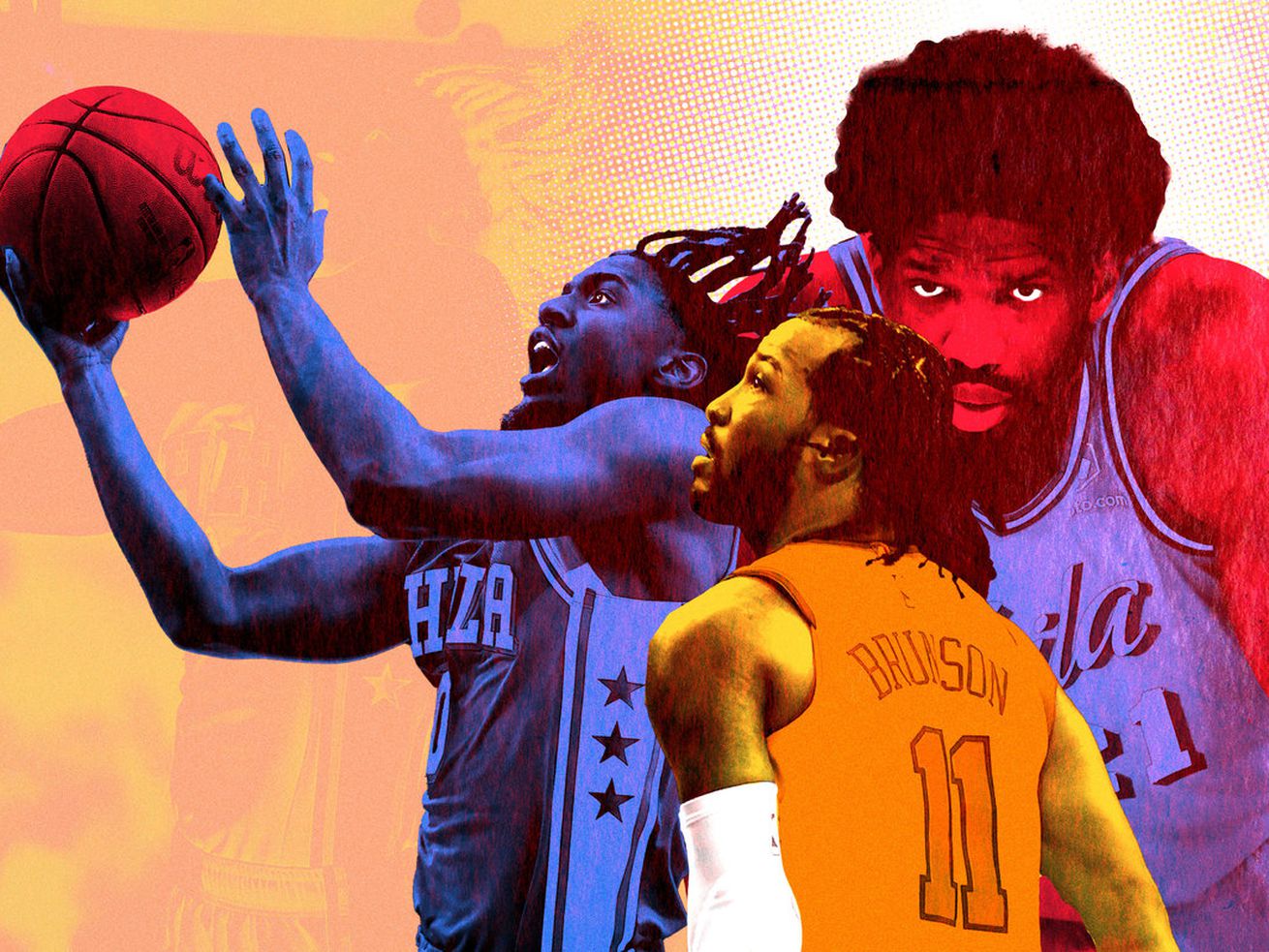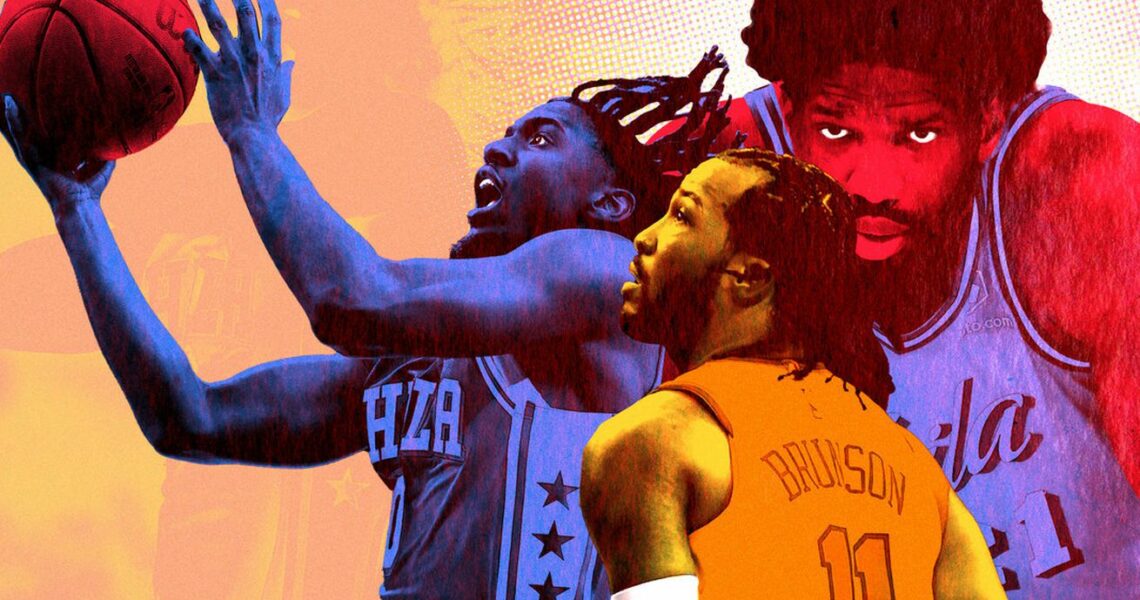
The New York Knicks are relying on their star point guard to get them to the second round. In a way, the Sixers are, too.
Down three at half time of a must-win Game 3, the Philadelphia 76ers realized their wisest offensive tack would be relentlessly exploiting the New York Knicks’ most unsettling defensive flaw. Translation: Philly hunted Jalen Brunson.
On the Sixers’ very first play of the third quarter, Kyle Lowry (Brunson’s defensive assignment) set a wide pindown for Tyrese Maxey that was designed to catapult him toward a dribble handoff with Joel Embiid. It’s a pet action that’s hard to stop for multiple reasons, but Tom Thibodeau’s Knicks were ready. Instead of switching off the ball and ceding the mismatch or having to trail one of the sport’s fastest players, OG Anunoby top-locked Maxey and kept him in the corner.
It didn’t matter. The Sixers were happy to flow into a counter, with Lowry running the dribble handoff instead, forcing Brunson to fight around Embiid’s screen before eventually switching onto him at the nail, an area where defenders who stand 10 inches taller than New York’s point guard are completely helpless. Translation: On his way to dropping 50 points, this was easy money for Embiid.
Subtly, some plays—like the one above—wind up defining an entire series. The second half of Game 3 was full of them, as Philadelphia shot itself back into the first-round’s most compelling and competitive dogfight by targeting New York’s best player over and over and over again. The Knicks are still up 2-1, but their lead hardly feels significant, coming off a Game 2 that could’ve easily gone the other way, followed by Embiid saving the day (like we said he might).
Throw in how Philly won Thursday and it’s not hard to understand why it should feel so confident going forward. The Sixers cashed in on an unambiguous advantage and were more focused on attacking Brunson than any other stretch in the series. It didn’t catch New York by surprise, either. None of this is new for Thibs. Teams all season have gone at Brunson in numerous ways, and the Knicks are ready with a quick hedge or switch with plenty of help behind the play. But sometimes there isn’t enough data in the world to save a team from its most transparent liability—there’s no adjustment to make someone taller, stronger, faster, or add a couple inches to their wingspan.
It’s of course not all Brunson’s fault that Philly scored 43 points in Thursday’s third quarter while generating a ludicrous 204.8 points per 100 possessions over those 12 minutes, but these two happenings are also not a coincidence. Good things happened for the Sixers when Brunson had to work at the point of attack, even after he stopped switching.
When Philly started to run stagger screens for Maxey with Lowry and Embiid, Brunson would start by dropping back before he found himself as a third defender on the weakside, having to either take away Embiid’s pop behind the 3-point line (which didn’t go well) or a skip pass to Lowry (ditto):
The Sixers have been more than happy to plop one of the shortest players on the court in a help position, either as the last line of defense or as the defender forced to cover an impossible amount of ground on a single-side tag, as seen below:
There’s no shame in getting put on skates by someone as frantic as Maxey, but that doesn’t change the fact that Brunson is exactly who the Sixers want in front of their own All-Star point guard:
When he switched onto the ball, Brunson would try to take away Maxey’s right hand and force him to the sideline. But Isaiah Hartenstein still had to help, giving Embiid more time and space than he should ever be given on the pass back:
Near the end of the fourth, after the Knicks had cycled through several responses to the Sixers’ game plan—switching, hedging, changing his matchup—there was a telling moment of frustration for the Knicks when Lowry went to set a ball screen and was knocked down by an overeager Anunoby, who refused to surrender a mismatch on Brunson’s behalf. The Sixers were in the bonus.
It happened a few minutes after Embiid waved Nic Batum up for another ball screen. The offensive alignment was as predictable as it was effective, ending in another 3 for Embiid, launched over Brunson’s helpless contest:
The strategy was self-evident coming into this series. Preying on individual weak links is ubiquitous in contemporary playoff basketball. The Sixers did have some success involving Brunson in their actions through the first two games, but they tapped into the approach even more in Game 3.
Before Game 2, I asked Nick Nurse about how critical targeting Brunson can be in this series. “Listen, I think that we did do some actions that we’re trying to put certain people in. [Brunson] ended up in quite a bit of them because of where they put him as well, how they matched him up,” he said. “Again, that’s [the] kind of information we have now but they could switch it. Right? So I imagine we will run some of that stuff again.”
The Sixers have gone at Brunson in multiple ways in this series, with those initial matchups dictating how the play will unfold. If, say, he’s hiding on Buddy Hield, then the Sixers aren’t likely to go out of their way to expand a struggling bench player’s offensive role. Nurse has some say there. He benched Hield in Game 3, erasing a safe place for Brunson to take defensive possessions off. Instead, Lowry, Batum, and Kelly Oubre Jr. were the only options all night.
There’s a noticeable downside when someone so (relatively) small is forced to engage on both ends through the rigors of a physical playoff series. Play after play, quarter after quarter, game after game, the toll that takes on a relatively small body is hefty and non-negotiable. Attacking Brunson repeatedly, early and often, has various benefits that may be on display for the rest of this series. The plan’s incentives are twofold: (1.) Brunson is not a bad team defender but has limitations on the ball; (2.) making him do all this stuff on top of being responsible for generating so much of New York’s offense is exhausting and, possibly, unsustainable.
Sometimes the best defense is a good offense. Despite playing mostly out of his mind, finishing with 39 points and 13 assists with a 60.4 true shooting percentage, Brunson made just one basket in the fourth quarter and committed two bad-pass turnovers that probably don’t happen if he isn’t drained.
Playoff basketball, with its layered stakes, rigid physicality, and unquantifiable luck, is essentially a mounting series of possessions that, sooner or later, reveal the answer to an elemental question: Which team has made the other more uncomfortable, preferably to the point where they alter, doubt, or intentionally abandon an identity they’d been cultivating for the past six months?
The Knicks don’t like to switch. And despite having a speedy All-Star point guard, the Sixers aren’t typically hard pressed to hunt for mismatches, which makes obvious sense with Embiid on the court. But in this matchup, Philadelphia’s great advantage might lie in how often it can directly involve the undersized Brunson in whatever action it happens to be running.
The Sixers’ offensive blueprint in Game 3 won’t guarantee success going forward—just because you get the mismatch doesn’t mean the shots will fall; it’s easier to score on New York when Mitchell Robinson is injured—but when push came to shove, they leaned on a tactic that gave them the best chance to win, full of beneficial ripple effects, while imposing their will and poking a hole the Knicks may not be able to sew up. There might not be a more fascinating and important chess match in the entire first round.
Expect to see more of the same in Game 4, against a smart defense that will tinker with different matchups to keep Brunson out of harm’s way. (Sticking him on Tobias Harris could be an interesting wrinkle.) There are countless variables found elsewhere that could decide which team advances to Round 2, but this game within the game may still be the most important one.

